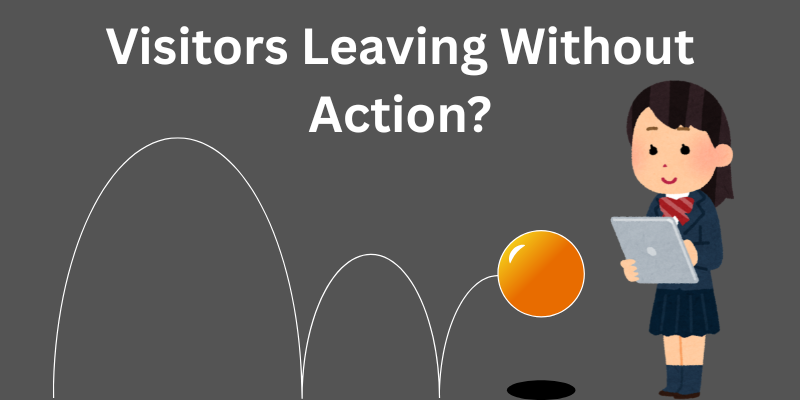How to Reduce Bounce Rate | 5 Tips to Improve User Experience
Published: 21/May/2025
Are visitors leaving your website without exploring other pages? You’re not alone. A high bounce rate can hurt your search engine rankings, reduce conversions, and lower your site’s credibility. Whether running a blog, an e-commerce site, or a digital marketing campaign, learning how to reduce bounce rate is crucial.
Many businesses struggle to keep users engaged. Why? Because the user experience isn’t strong enough to keep visitors interested. According to a study by Contentsquare, the average bounce rate across industries is 47%. That means nearly half of your traffic might be leaving without doing anything.

So, what is reducing the bounce rate all about? It simply means creating a better experience that encourages users to stick around. Let’s explore practical tips for reducing the bounce rate and boosting your site’s performance.
Agitation
Let’s face it, you’ve spent time, effort, and money bringing people to your website. But if most of them leave in seconds, what’s the point?
Imagine owning an online store and watching hundreds of users visit daily, but barely anyone buys. That’s frustrating. In digital marketing, this scenario is common, especially if your site loads slowly, looks confusing, or lacks clear information. You need to solve this.
A lower bounce rate means your audience is connecting with your content. It shows trust and interest. If you don’t take action, you’ll keep losing leads, customers, and opportunities.
Solution
Here are 5 simple but powerful ways to reduce bounce rate and improve user experience. These strategies apply to blogs, e-commerce sites, WordPress platforms, and even email marketing campaigns. Let’s go!
1. Improve Page Load Speed
Why it matters: According to Google, 53% of mobile users leave a site if it takes more than 3 seconds to load. A slow site increases bounce rate fast.
What you can do:
- Compress images using tools like TinyPNG.
- Use a fast hosting provider.
- Enable browser caching.
- Minimize unnecessary code (CSS, JavaScript).
Real-life tip: If you use WordPress, install a plugin like WP Rocket. It helps reduce bounce rate and WordPress issues by speeding up your site.
Stats show a 1-second delay can reduce conversions by 7%. Faster sites don’t just perform better. They also reduce the bounce rate on the website significantly.
2. Make Your Content Easy to Read
Why it matters: Visitors want answers fast. If your content looks like a wall of text, they won’t stay.
What you can do:
- Use clear headings and subheadings.
- Keep paragraphs short.
- Use bullet points and lists.
- Highlight important points in bold.
Real-life example: A fitness blogger noticed users leaving her site quickly. She added headings, visuals, and summaries. Her bounce rate dropped by 20% in one month.
Tip to reduce bounce rate: Always match your content to your audience’s reading level.
3. Use Internal Linking and Navigation
Why it matters: If your site doesn’t guide users to other pages, they won’t explore. Internal linking improves SEO and helps users find more value.
What you can do:
- Link related blog posts and products.
- Use a clean menu bar.
- Add a search bar.
Example: On an e-commerce site, link product pages to related categories or reviews. This is key for how to reduce the bounce rate of a website’s e-commerce section.
Bonus tip: Clear calls to action (CTAs) like “Read More” or “Check This Out” keep users clicking.
4. Add Engaging Media
Why it matters: Videos, images, and infographics grab attention. They explain things faster than words and keep users on your site longer.
What you can do:
- Add product demo videos.
- Use real photos.
- Create custom graphics.
Fun fact: According to Wistia, pages with videos can increase time-on-site by 2.6x.
How does video reduce bounce rate? It helps visitors understand your message quickly, which builds trust.
Pro tip: Use autoplay videos carefully. Too many can annoy users, increasing bounce instead of reducing it.
5. Optimize for Mobile and User Experience
Why it matters: Over 60% of web traffic comes from mobile. If your site isn’t mobile-friendly, users will bounce.
What you can do:
- Use a responsive design.
- Test your site on different screen sizes.
- Make buttons easy to tap.
- Avoid pop-ups that block content.
How can you reduce the bounce rate on mobile? Focus on simplicity. Make sure your layout is clean and easy to navigate.
In digital marketing, reducing bounce rate means creating a smooth journey. Users should never struggle to find what they need.
More Ways to Reduce Bounce Rate
Let’s add a few bonus strategies to help you even more:
Use Exit-Intent Popups (Smartly)
These popups appear when a user is about to leave. Offer discounts, free guides, or newsletters to grab attention.
Improve Email Marketing Links
If you’re running email campaigns, make sure your links lead to relevant, useful pages. That’s how to reduce bounce rate in email marketing effectively.
Match Content to Keywords
Don’t trick users with misleading titles. If someone searches “how to reduce bounce rate in Google Analytics,” make sure your page explains that clearly.
Monitor Bounce Rate in Google Analytics
Track which pages have high bounce rates. Fix them first. Google Analytics gives you a full picture.
FAQs
1. What does “reduce bounce rate” mean?
Reducing bounce rate means keeping visitors on your website longer. A bounce happens when someone visits one page and leaves without clicking anything else. A lower bounce rate shows that people find your site helpful and want to explore more. It also means your content is working well, which helps improve your rankings in search engines.
2. How can you reduce the bounce rate on a website?
You can reduce the bounce rate on your website by improving the user experience. Here are some easy tips:
- Make your website load faster.
- Use clear headlines and easy-to-read content.
- Add internal links to guide users to other pages.
- Use high-quality images and videos.
- Make sure your site looks good on mobile devices.
These small changes can keep visitors engaged and lower bounce rates.
3. How to reduce bounce rate in Google Analytics?
To reduce bounce rate in Google Analytics, start by checking your bounce rate data. Find out which pages have high bounce rates. Then:
- Improve the content on those pages.
- Add buttons or links to guide users to more content.
- Use engaging media like videos.
- Fix slow-loading pages.
- Use event tracking to understand what users do before leaving.
This helps you improve specific pages based on real user behavior.
4. How does video reduce bounce rate?
Videos grab attention fast. When you add videos to your website, people stay longer to watch them. This increases the time they spend on your site, which helps reduce the bounce rate. For example, a short “how-to” video or a product demo can keep users engaged and encourage them to click through to other pages.
5. What are some tips to reduce bounce rate in email marketing?
If you’re doing email marketing, your bounce rate still matters. Here’s how to reduce it:
- Write catchy subject lines.
- Keep your emails short and helpful.
- Link to landing pages that match your email topic.
- Make sure those pages are mobile-friendly and load fast.
- Use clear call-to-action buttons.
This way, users won’t leave right away after clicking your email.
6. What is a good bounce rate for e-commerce websites?
For e-commerce websites, a bounce rate between 20% to 40% is considered good. If it’s higher than 50%, it’s time to check your product pages. Ask yourself:
- Is the product description clear?
- Are the images high-quality?
- Does the page load fast?
- Are there related products linked?
Improving these things can help reduce the bounce rate of a website’s e-commerce section and increase sales.
Conclusion
If you want to grow online, you need to reduce your bounce rate. It’s not about tricks; it’s about giving people a better experience.
- Make your site fast.
- Write content that’s easy to read.
- Help users explore more.
- Add engaging videos and graphics.
- Make everything mobile-friendly.
Whether you run a blog or a store, these tips to reduce bounce rate will help you keep visitors longer and turn clicks into conversions.
Remember, every second counts. Start small, track your progress, and keep improving. That’s the real secret to how to reduce bounce rate and build trust with your audience.
These posts could interest you!
- Why focus on retargeting ads to increase sales?
- The power of interactive content in digital marketing





